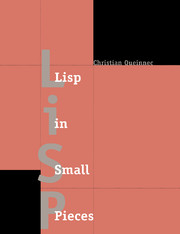Book contents
- Frontmatter
- Contents
- To the Reader
- 1 The Basics of Interpretation
- 2 Lisp, 1, 2, … ω
- 3 Escape & Return: Continuations
- 4 Assignment and Side Effects
- 5 Denotational Semantics
- 6 Fast Interpretation
- 7 Compilation
- 8 Evaluation & Reflection
- 9 Macros: Their Use & Abuse
- 10 Compiling into C
- 11 Essence of an Object System
- Answers to Exercises
- Bibliography
- Index
2 - Lisp, 1, 2, … ω
Published online by Cambridge University Press: 05 June 2012
- Frontmatter
- Contents
- To the Reader
- 1 The Basics of Interpretation
- 2 Lisp, 1, 2, … ω
- 3 Escape & Return: Continuations
- 4 Assignment and Side Effects
- 5 Denotational Semantics
- 6 Fast Interpretation
- 7 Compilation
- 8 Evaluation & Reflection
- 9 Macros: Their Use & Abuse
- 10 Compiling into C
- 11 Essence of an Object System
- Answers to Exercises
- Bibliography
- Index
Summary
Since functions occupy a central place in Lisp, and because their efficiency is so crucial, there have been many experiments and a great deal of research about functions. Indeed, some of those experiments continue today. This chapter explains various ways of thinking about functions and functional applications. It will carry us up to what we'll call Lisp1 or Lisp2, their differences depending on the concept of separate name spaces. The chapter closes with a look at recursion and its implementation in these various contexts.
Among all the objects that an evaluator can handle, a function represents a very special case. This basic type has a special creator, lambda, and at least one legal operation: application. We could hardly constrain a type less without stripping away all its utility. Incidentally, this fact—that it has few qualities—makes a function particularly attractive for specifications or encapsulations because it is opaque and thus allows only what it is programmed for. We can, for example, use functions to represent objects that have fields and methods (that is, data members and member functions) as in [AR88]. Scheme-users are particularly appreciative of functions.
Attempts to increase the efficiency of functions have motivated many, often incompatible, variations. Historically, Lisp 1.5 [MAE+62] did not recognize the idea of a functional object. Its internals were such, by the way, that a variable, a function, a macro—all three—could co-exist with the same name, and at the same time, the three were represented with different properties (APVAL, EXPR, or MACRO) on the P-list of the associated symbol.
- Type
- Chapter
- Information
- Lisp in Small Pieces , pp. 31 - 70Publisher: Cambridge University PressPrint publication year: 1996



